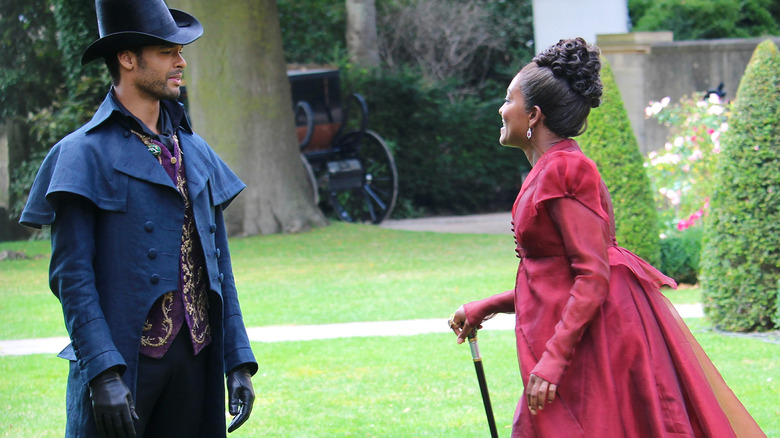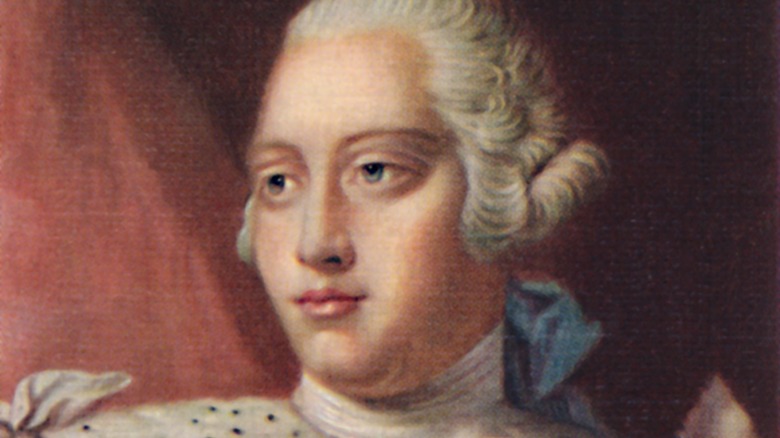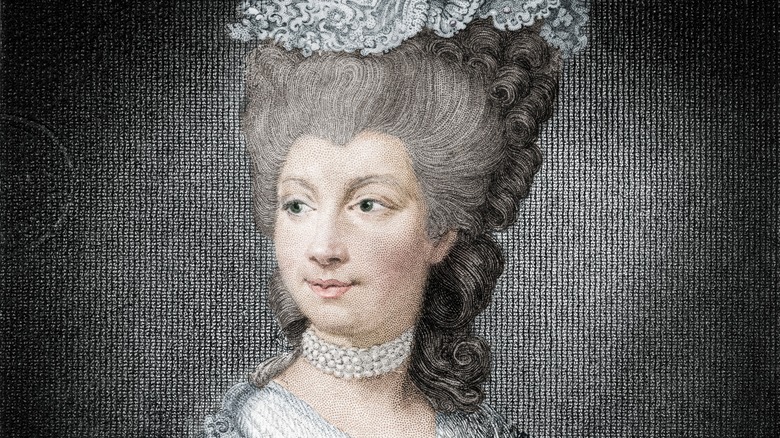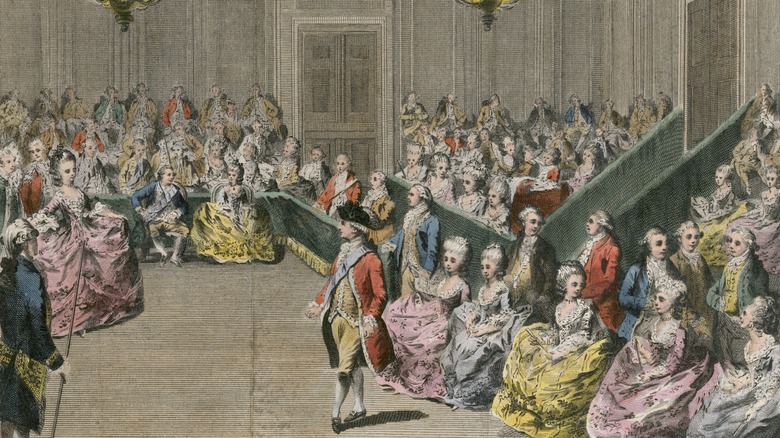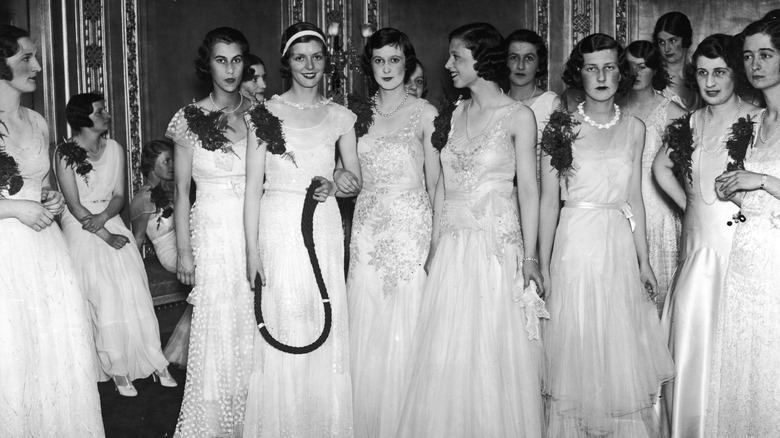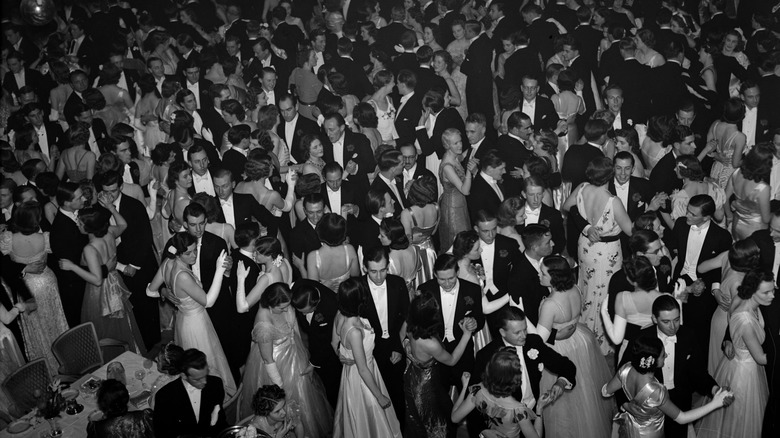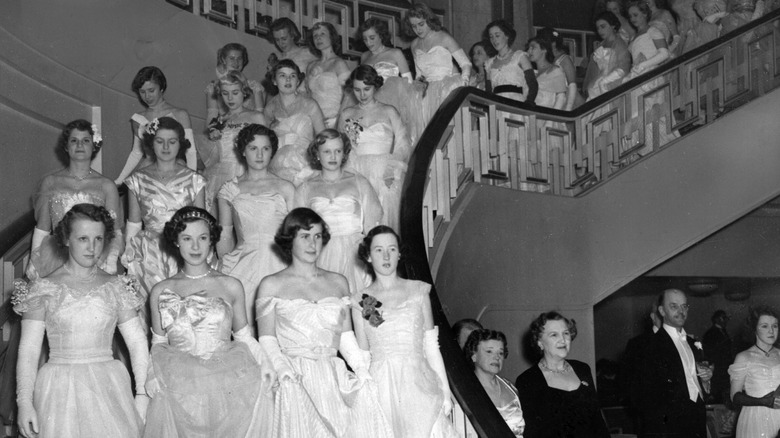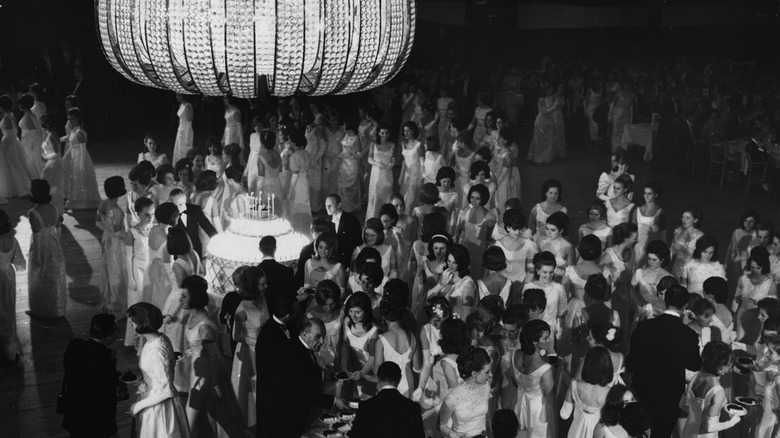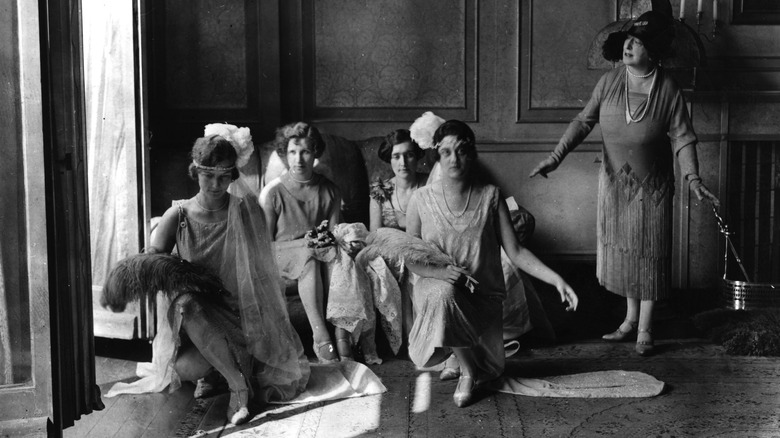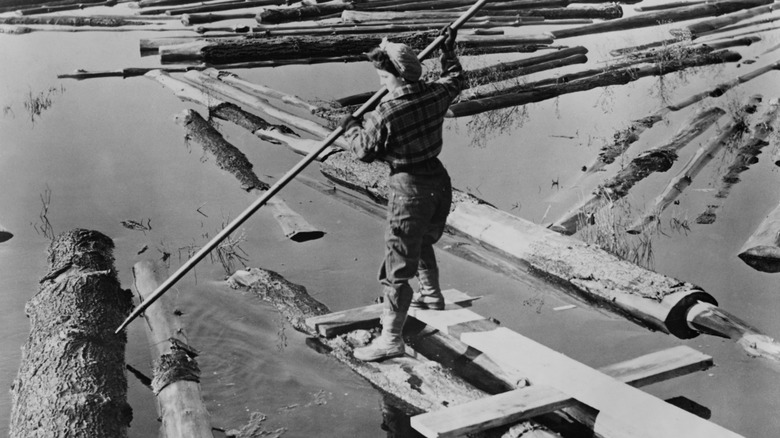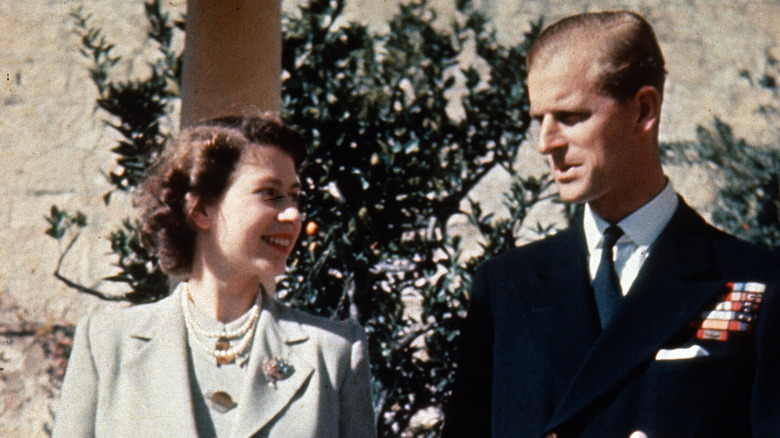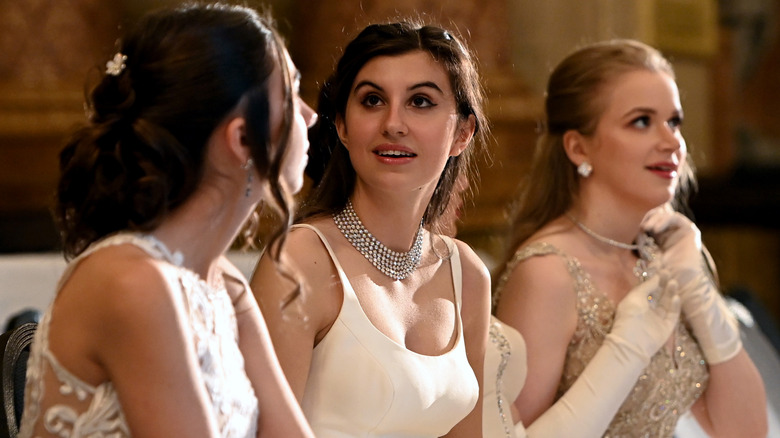The Real-Life History Of Queen Charlotte's Ball
Although the most-viewed show on Netflix continues to be "Squid Game" at 571.76 million hours viewed, the second season of "Bridgerton" has clinched the second spot (via Variety). During the first seven days of streaming, from March 28 through April 3, fans of the show viewed 251.76 million hours of the Regency-era fave. Fast on the heels of season two are the stats for season one of "Bridgerton," which ranked as the most popular Netflix title in English during the last week of March 2022 at 53 million views.
In other words, there's a massive appetite for formal ballroom events featuring lavish costumes and elegant music. There's also plenty of thirst for romance, sentimentality, and titillating sex scenes. "Bridgerton" provides all of this in spades, along with a diverse and gorgeous cast of actors and enough historical details to inspire all the feels of a historical romance. This winning combo means the show will continue to slay the competition. Of course, the show centers around the court of King George III and Queen Charlotte, and the debutantes who frequent the many balls and events hosted by the crown.
But what was it really like being a debutante at Queen Charlotte's Ball? Here's everything you need to know about the historical event that inspired "Bridgerton" and why it persists today.
It all started with King George III
In 1780, King George III launched the first Queen Charlotte's Ball to celebrate his wife's birthday, per The Telegraph. Born in Mirow, situated in northeastern Germany, Charlotte Sophia of Mecklenburg-Strelitz proved one of the only eligible bachelorettes when King George III searched for a wife, as reported by the Royal Collection Trust. According to Britannica, they married in 1761 after a very brief introduction.
Despite forging a relationship based on political strategy, the couple's relationship evolved into a passionate love match, producing 15 children. So, it makes sense that the King would want to honor his beloved wife publicly. The original event acted as a fundraiser for a cause close to the Queen's heart, the Queen Charlotte's and Chelsea Hospital, one of the United Kingdom's oldest maternity wards, according to the National Health Service.
Two hundred years after the ball launched, presenting debutantes to the Queen came to an abrupt end, spearheaded by the royal family, per Town and Country. The last debutantes came before the Queen in 1958, but Queen Charlotte's Ball continued into the mid-1970s. Nevertheless, rumors abounded that the ball had turned crass, brought low "amid rumours of drug-taking and general 'loucheness'" (via The Telegraph). Not quite what King George III intended.
Who was Queen Charlotte?
In the streaming series "Bridgerton," Queen Charlotte is played by Golda Rosheuvel to great acclaim, as reported by History Extra. Rosheuvel brings the perfect admixture of gravity, elegance, and strict adherence to detail to her character's portrayal. In reality, we know that Queen Charlotte had a deep love for tradition, which dictated every aspect of the court she kept. For example, her ladies-in-waiting continued to wear 18th-century gowns and hairstyles well after significant changes happened on the fashion front.
This strict adherence to the old-fashioned way of doing things led some to condemn the king and queen as stuffy. But Queen Charlotte also went to great lengths to provide her children with a loving family atmosphere and incredible memories. She had menageries and gardens designed specifically for her children to enjoy, and she transformed her palaces at Kew and Windsor into hearths of domesticity. Instead of dabbling in politics, Queen Charlotte focused on all things familial, and she also placed a premium on loyalty and trust.
While winning a place at her court proved difficult, trusted ladies-in-waiting earned lifetime friendships with the queen. These relationships proved essential supports, as her beloved husband, King George III, descended into madness, per the Royal Collection Trust. By 1811, he was declared insane and entrusted to his wife's custody while their son, George IV, took the throne (via Britannica).
The party involved cake and curtseys
Traditionally, Queen Charlotte's Ball required strict adherence to the rules, as reported by Town and Country. Not surprising considering the queen's love of formality and age-old customs. Debutantes had to wear formal gowns, complete with trains. Among their accessories, they carried fans, floral bouquets, and three feathers in their hair. At its high point, the Ball culminated in getting presented before the queen, who stood next to a massive birthday cake to receive debutantes. When each debutante came before the sovereign, they curtseyed respectfully.
According to History Extra, curtseying proved no joke. Today's debutantes continue to spend months practicing this unnatural yet elegant move. To execute it, practitioners must place their left knee in a locked position behind the right. Next, they bow deeply while facing the queen (or cake in later years). In other words, this move required plenty of balance.
Soon, the party had developed into the premier debutante ball of the burgeoning season where eligible bachelorettes hoped to snag a prize-worthy husband. They ultimately had a year to complete their mission or risk the spinster label, a fate no woman wanted to have thrust involuntarily upon her. Oddly enough, the cake and the curtseying tradition continues today featuring an audacious and towering confection.
The ball after Queen Charlotte
Queen Charlotte died in 1818, according to History Extra, but the ball proved such a smashing success that it continued with noble and gentry families relishing the chance to present their daughters before the British royal family, as reported by Time. The heyday of the ball stretched from 1780 to 1914, and although it persisted well after World War I, it lost some of its glitter, prominence, and charm before disintegrating under the weight of royal criticism.
During the height of the ball's influence, Great Britain boasted worldwide reach as a colonial power, according to World Atlas. Referred to as the "empire where the sun never set" this title alluded to English landholdings in various time zones across the planet. All told, Britain boasted ownership of 25 percent of the Earth's landmasses. So, Queen Charlotte's Ball provided an essential networking opportunity for influential families located in the empire's hinterlands. Well-off young bachelorettes went to great lengths for a debut in London, even if it entailed a sea voyage.
As for women who couldn't travel, they found other ways to opt into the debutante fun. While they might not be able to curtsey in London in front of England's monarch, they could attend balls structured around the same concept. There, they curtseyed to mayors or other small-town officials, retaining hints of the original event's idea. Queen Charlotte's dance spawned a cultural phenomenon and rite of passage with global reach (via History Extra).
Life after presentation at Queen Charlotte's Ball
You may be wondering what happened to debutantes after their presentation at Queen Charlotte's Ball, and this is an excellent question. Although outcomes varied based on each debutante's experiences and success in capturing the attention of a worthy fiancé, most went on to attend a season's worth of events (via History Extra).
After presentation at Queen Charlotte's Ball, a world of social opportunities greeted debutantes. They included everything from horse races to other formal balls and countless parties. The constant string of social events generally lasted from March through October. And these activities offered numerous chances to network, forge new friendships with women of similar backgrounds and education levels, and, of course, opportunities to cement their marriage prospects.
But the London season didn't prove the be-all, end-all when it came to the debutante experience. After this scene ended for the year, Scotland hosted more debutante activities, and various parties at country estates also attracted debs. In some cases, debutantes proved unable to complete an entire season. For example, women who lived overseas might only have the funds to stay for the presentation to the monarch before returning home. And some debutantes, like Nicolette Harrison, received marriage proposals so early in the season that they eschewed the remaining activities in favor of wedding planning, per Fiona MacCarthy's "Last Curtsey: The End of the Debutantes."
Queen Charlotte's Ball meant the pressure was on
In the 18th and 19th centuries, Queen Charlotte's Ball ushered in a debutante season filled with plenty of social obligations and pressure, as reported by Town and Country. By pressure, we're referring to the debutante's need to find and secure an eligible bachelor before the season ended.
Women unlucky enough to get through an entire season (or two) without a proposal ended up shelved. For many, this ushered in lifelong spinsterhood. Considering that most women couldn't work outside of the home, this left them at the mercy of their male relatives, who might or might not agree to support them. If this sounds like a familiar theme, you've likely had brushes with Jane Austen's work. Her romances place a primary focus on the financial disparities existing between men and women, especially those necessitating a fortuitous match (via Pursuit).
According to Kensington Books, spinsters referred to unmarried women past the prime marriage age. For individuals living during England's Regency period, spinsterhood could begin as early as 24 years old, and by the age of 29, many assumed all hope was lost. Unmarried women forged challenging existences because they weren't permitted to make a living without getting shunned by society. When opportunity allowed, they became caretakers for sick relatives or worked as governesses to secure places to live.
The debutante's profile and requirements
While debutantes came from noble and gentry families, lineage alone didn't secure them a place at Queen Charlotte's Ball, according to Town and Country. Traditionally, debutantes needed to fall between 16 and 18 years old, although some allowances were made for debs in their early twenties (via History Extra). They had to be unmarried virgins (ideally), and divorced women couldn't participate, even when the whole shebang ended in 1958. Such requirements showed just how far behind the times the British monarchy lagged.
Debutantes also required appropriate wardrobes for the events they needed to attend. Frequently, pieces came from high-end department stores such as Harrods. They also needed to invest in a custom-made white gown for the Queen Charlotte's Ball and presentation before the monarch. Debs also needed evening gowns in other colors for some of the more renowned London balls.
As for the rest of their wardrobe, they required suitable pieces in chiffon and silk for events like the Fourth of June at Eton, Henley, and Ascot. By the 1950s, shorter dresses worked for country parties. Matching accessories, from hats to gloves and handbags, rounded out a carefully crafted debutante's wardrobe. Besides looking the part, debs also took etiquette and dance classes to guarantee they'd make a noble splash during their season out.
The role of the debutante's chaperone
Besides the fancy wardrobes and classes for etiquette and dance, debutantes needed chaperones to present them, per Town and Country. Each chaperone, in turn, had to have a history as a debutante, which ensured a limited pool of participants. This chaperone tended to be a family member or friend of the family.
By the 20th century, the demand for chaperones devolved into a money-making scheme for some, with titled chaperones low on dough going to the highest bidder. At this point, you may be wondering what the chaperone got paid to do. Ultimately, she fulfilled a variety of jobs depending on the needs of individual clients. Paid chaperones proved especially helpful to American heiresses big on money but devoid of noble ties.
Chaperone responsibilities included writing to the Lord Chamberlain to apply for an invitation. Invitations not only got girls into the ball but came with two cards permitting the debutantes to enter the Ball Supper Room and approach the Queen for their curtsey. Chaperones also assisted girls with unfamiliar activities and protocols, thereby increasing their chances of successfully navigating some of the world's elitist waters and snagging a hubby along the way.
Why the debutante tradition came to an end
By the 1950s, Queen Charlotte's Ball had been called into question by a surprising faction: the British royal family (via Town and Country). As the centuries had passed and England had transformed from Great Britain to the United Kingdom in the wake of two world wars, the tradition looked increasingly snobbish and stifling.
It also appeared out of step with societal changes caused by the two world wars, such as the introduction of women into the workforce, and it felt largely irrelevant to many British nobles who felt more concerned about budgeting and finding ways to keep their country estates than doling out thousands of dollars for their daughters to party in formal wear. Coupled with the fact marriages of convenience had fallen out of favor, the whole thing lacked practicality.
Perhaps the Duke of Edinburgh said it best when he declared it "bloody daft." As for Princess Margaret, she reportedly lashed out against the practice of hiring chaperones: "They're letting every tart in London in" (via Town and Country). Formal presentation before the Queen ended officially in 1958, and Queen Charlotte's Ball halted in 1976, according to History Extra. Families hoping to introduce their daughters to eligible bachelors turned to garden parties and other social events to fill the gap.
Queen Elizabeth modernized the monarchy
Besides the harsh comments about Queen Charlotte's Ball and the debutante tradition, some also argue that Queen Elizabeth II responded to changes within society when she brought the event to an end, as reported by Town and Country. Getting rid of a tradition that many felt subjugated women and presented them meat-market style (via Town and Country), looked more like common sense than iconoclastic social upheaval.
Queen Elizabeth II represented the first monarch whose coronation got televised to the world, and this came with responsibilities different than those of her predecessors. Many of her subjects believed the monarch needed to modernize the ancient ruling class she now headed up. By no means an easy task, one thing proved evident: Queen Charlotte's Ball had to go.
But even if Queen Elizabeth II hadn't ended the ball in 1958, the writing was on the social wall. As Britain sat poised at the end of the 1950s and the beginning of the 1960s, mid-century debutantes soon ushered in the Age of Aquarius. With this came the sexual revolution and second-wave feminism, which put marriage at the bottom of the priority list. Many felt the debutante scene reeked of inequality and repression. In other words, societal shifts helped take down the event.
Queen Charlotte's Ball continues today
When Queen Charlotte's Ball folded in the 1970s, Peter Townend, The Tatler's social editor, kept it on life support by covering garden parties, dances, and fashion shows (via the Independent). He tried to resuscitate Queen Charlotte's Ball, too, although it completely fizzled by 1997.
But Townend's friend, Jenny Hallam-Pell, revived it in the 21st century. A former debutante and attorney in Knightsbridge, she remains dedicated to restoring the debutante season that once existed. She sees value in the tradition, which gives young and influential women the chance to enter high society properly. But that doesn't mean Hallam-Pell wants to bring every aspect of the original event back to life. Instead, she's pushing an updated version that has replaced husband hunting with business networking and etiquette.
Hallam-Pell has also gotten creative when it comes to presenting debs to royalty. Instead of British nobles, she's turned to members of royal blood from the world over. For example, in 2009, this included European blue bloods like Princess Olga Romanov of Russia, Princess Katarina of Yugoslavia, and the Duke of Anjou and Cadiz, Don Alfonso di Borbon y Franco. Hallam-Pell argues, "People want to re-instate some of the proud institutions that defined Britain's identity, and I believe debutantes are very much part of that." Considering the current popularity of "Bridgerton," Hallam-Pell's picked the ideal moment for this venture. However, creating an event on a par with its historical predecessor remains unlikely, per Town and Country.
